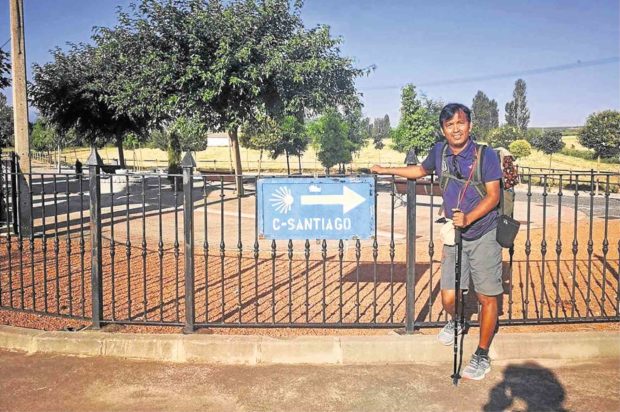
Bro. Jun Santiago has taken his mission from Baclaran Church to an 816-kilometer route on Spanish soil.—CONTRIBUTED PHOTOS
A Redemptorist brother and photography enthusiast is now well into his planned 816-kilometer, 40-day walk in the pilgrimage site of Camino de Santiago in Spain to raise awareness about the spate of drug-related extrajudicial killings (EJKs) in the Philippines.
Bro. Jun Santiago of the National Shrine of Our Mother of Perpetual Help in Baclaran, Parañaque City, says the theme of his journey is “Babang Luksa,” a Filipino tradition in which relatives offer prayers for the departed a year after a person’s death.
“I would think of it as ‘babang luksa’ to help motivate me to go the distance,” says Santiago, who has helped document the bloody war on drugs under the administration of President Duterte.
Santiago says he experienced exhaustion and sore feet in the first few days of his journey in Galicia, in northwestern Spain, that began on July 21.
The Camino de Santiago, also known as the Way of St. James, is the name of any of the pilgrimage routes to the shrine of the apostle St. James the Great in the Cathedral of Santiago de Compostela, where tradition has it that the remains of the saint are buried.
Santiago’s campaign to create awareness about the killings started in the streets and slums of Metro Manila on Dec. 1. A camera buff, he joined a group of journalists that covered the bloody war on drugs, his advocacy and photographs reaching as far as the United Nations offices in Geneva.
He initially planned to make the pilgrimage in Spain as part of his personal vocation and devotion to God. But when the war on drugs became deadly, Santiago turned it into a pilgrimage for a cause.
One of the messages left by Santiago for fellow pilgrims to see
Prayer also for killers
“It has become a pilgrimage for a cause because the journey would be more meaningful if we dedicate it to something or if it becomes a bridge, particularly for the poor who fall victim to the senseless killings every night because of the war on drugs,” Santiago says.
In this sacred journey, Santiago says he is praying not only for the victims and their families but also for the killers.
“I want to be able to offer prayers for the families that were left behind and for the perpetrators,” he said in an earlier interview with the Inquirer. “May [God] open their minds and show them that there are many other ways to solve the country’s drug problem.”
To inform other pilgrims about his cause, Santiago has been leaving behind notes at every crossroad and turn on the trail. The notes read: “Stop the killings in the Philippines! Stop killing the poor.”
Streets turning red
He has also posted photographs of the grisly murders to show the pilgrims how the streets in the Philippines have turned red because of the war on drugs. Among the images was that of Michael Siaron, a suspected drug user, left lying in his own blood after he was shot dead by masked men in Pasay.
“The crossroad symbolizes a person’s attitude, a point in life where you stop and ask yourself questions. The turn, meanwhile, symbolizes the challenges each one of us faces in life,” he said, referring to the places where he posts his notes and photos.
Santiago has created two social media accounts so that people can follow his pilgrimage: “Camino de Santiago, a pilgrimage for a cause” on Facebook and an Instagram account @Santiago.Journey
He says the trail of Camino de Santiago, a Unesco heritage site, is long and wide and perfect for prayers and reflection. The pilgrimage can take one of dozens of routes to Santiago de Compostela.
Santiago arrived in Galicia on July 22 and spent his first two days there for personal prayers and reflection. On the third day, he posted his first note on a tree in Roncesvalles, which he calls the Valley of Thorns.
It was the same day Mr. Duterte delivered his second State of the Nation Address (Sona) in Manila. During his speech, the President vowed that his war on drugs would now be relentless. In his first Sona the year before, Mr. Duterte said the campaign would last for only three months.
Santiago’s followers on social media have thanked him for his sacrifice. Many of his posts have reached more than 1,000 people and some of them have shared his photo collection. A Brazilian news outlet has also taken notice and published one of the lurid images he shot in the streets of Manila.
Another note on the Philippine drug war makes it to Camino de Santiago.
Crosses of the people
Last Thursday, Santiago reached Alto de la Grajera, the pilgrimage site’s highest point. Crosses made of barks and placed on wire fences reminded him of the victims’ grieving families.
“We decided to leave three images and they are a timely reminder of the crosses (in) this sacred journey,” he says. “They are the crosses of the people, especially the victims’ families.”
Even while in Spain, the religious brother says he keeps track of the killings in the Philippines and is saddened by news of the hardships experienced by the less fortunate.
Santiago shares the anguish of a family from an informal settlement in Navotas after strong monsoon rains soaked the coffin of their patriarch.
In the pilgrimage route’s rest areas, pilgrims approach Santiago to ask him about the notes and photos. Although he politely declines to offer an answer to questions about peace and order in the country, he says the pilgrims still offer prayers for the Filipinos.
The pilgrims know who Mr. Duterte really is, Santiago says, adding they don’t approve of the President’s jokes and commentaries.